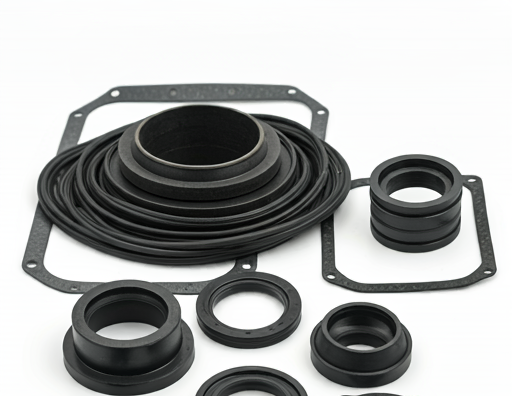Materials of Excellence
Crafting with the Best in the Business
At Julong Rubber, we prioritize using the finest materials to ensure the durability, efficiency, and performance of every product. Explore the various high-quality materials that form the foundation of our premium rubber components.

Butyl Rubber (IIR)
The Gas Barrier Specialist
Butyl Rubber, known technically as Isobutylene Isoprene Rubber (IIR), is distinguished by its outstanding impermeability to gases. This attribute, combined with its excellent resistance to heat, aging, weathering, chemical attack, and shock absorption, has positioned it as a valuable material in various applications. It offers impressive flexibility and remains stable over a wide range of temperatures. Additionally, Butyl Rubber is known for its superior dampening and vibration isolation properties, especially in applications requiring an air or watertight seal.
Butyl Rubber (IIR): Properties, Applications
Butyl rubber (IIR) is known for its superior air impermeability, weather resistance, and chemical stability. If you’re seeking materials for airtight sealing, chemical storage, or vibration damping, butyl rubber offers outstanding solutions. But how does it perform over time, and is it safe?
Butyl rubber (IIR) is a synthetic elastomer made from isobutylene and a small amount of isoprene. It offers excellent gas impermeability, heat resistance, and durability, making it ideal for tire inner liners, seals, and protective clothing.
What is Butyl Rubber?
Butyl rubber, also known as IIR (Isobutylene Isoprene Rubber), is a synthetic rubber produced by copolymerizing isobutylene (98-99%) with a small amount of isoprene (1-2%). This unique structure gives IIR its low gas permeability, chemical resistance, and excellent flexibility.
IIR rubber is primarily used where airtight sealing and resistance to aging are essential, such as tire inner tubes, chemical linings, and protective gear.
What are the Advantages and Disadvantages of IIR?
🏆 Advantages of Butyl Rubber (IIR)
| ✅ Advantage | 🔍 Description |
|---|---|
| 💨 Low Gas Permeability | Exceptional airtightness, ideal for inner tubes and seals. |
| ☀️ Weather and Ozone Resistance | Resists UV rays and ozone degradation. |
| 🧪 Chemical Resistance | Stable against polar solvents, acids, and alkalis. |
| 🔊 Vibration Damping | Excellent for absorbing shocks and reducing vibrations. |
| 🔥 Heat Resistance | Performs well at temperatures up to 120°C. |
⚠️ Disadvantages of Butyl Rubber (IIR)
| ❌ Disadvantage | 🔍 Description |
|---|---|
| 🛢️ Poor Oil Resistance | Not suitable for petroleum-based oils and fuels. |
| ⚗️ Poor Adhesion | Requires special primers for bonding to other materials. |
| ❄️ Limited Flexibility at Low Temps | Becomes stiff below -40°C (without modification). |
| 🔩 Slow Curing Rate | Longer vulcanization time compared to other rubbers. |
Application of Butyl Rubber (IIR)
Butyl Rubber is widely used due to its low gas permeability, excellent resistance to weathering and ozone, and superior vibration damping. Below, I explore its application in different industries with detailed technical comparisons.

🚗 Automotive Industry
Butyl Rubber is a key material in automotive sealing applications, especially in tire inner linings and vibration-damping components.
- ✅ Applications: Inner tubes, tubeless tire liners, window seals, vibration isolators, grommets.
- ✅ Key Advantages:
- Exceptional air retention, reducing the need for frequent inflation in tires.
- Excellent resistance to heat aging and ozone degradation in automotive seals.
- Superior vibration damping properties for smoother rides.
🔧 Automotive Material Performance Comparison
| Material | Air Impermeability | Weather Resistance | Vibration Damping |
|---|---|---|---|
| NBR | Good | Moderate | Good |
| EPDM | Poor | Excellent | Moderate |
| Butyl Rubber (IIR) | Excellent | Excellent | Excellent |
⚗️ Pharmaceutical & Medical Industry
Butyl Rubber is commonly used in medical stoppers and seals, particularly where air tightness and chemical inertness are essential.
- ✅ Applications: Pharmaceutical stoppers, IV seals, vial closures, syringe plungers.
- ✅ Key Advantages:
- Low gas permeability ensures product sterility by preventing contamination.
- Excellent resistance to chemical interactions, protecting sensitive formulations.
- Compatible with sterilization methods such as gamma radiation and steam autoclave.
🔧 Pharmaceutical Closure Material Comparison
| Material | Gas Permeability | Chemical Inertness | Sterilization Compatibility |
|---|---|---|---|
| Silicone | Poor | Excellent | Excellent |
| TPE | Moderate | Good | Limited |
| Butyl Rubber (IIR) | Excellent | Excellent | Excellent |
🏗️ Construction & Industrial Sealing
Butyl Rubber is preferred in construction and industrial sectors for its weather resistance and sealing properties.
- ✅ Applications: Sealants, glazing tapes, roofing membranes, industrial gaskets.
- ✅ Key Advantages:
- Outstanding weathering and UV resistance ensures long service life in outdoor applications.
- High flexibility allows excellent sealing performance on irregular surfaces.
- Strong adhesion to a wide range of substrates, including glass, metal, and plastics.
🔧 Industrial Sealing Material Comparison
| Material | UV Resistance | Flexibility | Adhesion to Substrates |
|---|---|---|---|
| EPDM | Excellent | Good | Moderate |
| Silicone | Excellent | Moderate | Good |
| Butyl Rubber (IIR) | Excellent | Excellent | Excellent |
⛽ Oil & Gas Industry
Butyl Rubber’s impermeability and chemical resistance make it a reliable choice in the oil and gas sector.
- ✅ Applications: Tank liners, pipeline gaskets, valve seals, storage bladders.
- ✅ Key Advantages:
- Superior resistance to gas permeation reduces leak risks in storage tanks.
- Performs in harsh chemical environments, including hydrocarbon exposure.
- Withstands outdoor conditions due to excellent ozone and weathering resistance.
🔧 Oil & Gas Sealing Material Comparison
| Material | Gas Permeability | Chemical Resistance | Ozone/Weather Resistance |
|---|---|---|---|
| NBR | Good | Good | Poor |
| EPDM | Poor | Moderate | Excellent |
| Butyl Rubber (IIR) | Excellent | Good | Excellent |
What Breaks Down Butyl Rubber?
Despite its excellent durability, certain factors can degrade IIR over time.
| ❌ Factor | ⚠️ Effect |
|---|---|
| Petroleum Oils and Solvents | Swelling and softening of the rubber. |
| High Temperatures (>150°C) | Accelerated aging and hardening. |
| Strong Oxidizing Agents | Chemical attack leading to cracks and brittleness. |
| Mechanical Stress without Protection | Surface cracking and degradation. |
Is Butyl Rubber Toxic?
No. Butyl rubber (IIR) is non-toxic and safe for industrial and medical applications.
🔒 Safety Considerations
- ✅ Commonly used in pharmaceutical stoppers and food-grade linings.
- ✅ Does not release harmful substances under normal operating conditions.
- ⚠️ During production or burning, it can release hazardous gases—ensure proper handling in manufacturing environments.
How Long Does Butyl Rubber Last?
With proper use and maintenance, butyl rubber products have an impressive lifespan.
| ⏳ Application | 🔍 Typical Lifespan |
|---|---|
| Tire Liners | 8-10 years |
| Seals and Gaskets | 10-15 years (indoors) |
| Chemical Linings | 10-20 years (protected environments) |
| Protective Clothing | 5-8 years (depending on exposure) |
🔧 Tips to Extend Service Life
- ✅ Store in a cool, dry place away from UV light.
- ✅ Avoid contact with petroleum oils or aggressive chemicals.
- ✅ Regular inspection for signs of aging and damage.
How to Choose Butyl Rubber (IIR)?
Choosing the right Butyl Rubber for your application involves evaluating key performance criteria. Here’s a detailed guide tailored for B2B procurement officers.
🔍 Step 1: Assess Application Requirements
- ✅ Need for gas and air tightness
- ✅ Resistance to UV, ozone, and weathering
- ✅ Chemical compatibility (hydrocarbons, acids, alkalis)
- ✅ Vibration damping and noise reduction capabilities
🔍 Step 2: Select the Correct Grade
| Grade | Primary Feature | Common Applications |
|---|---|---|
| Regular Butyl (IIR) | Low permeability, high damping | Tire inner liners, industrial sealants |
| Halogenated Butyl (CIIR/BIIR) | Improved chemical resistance, adhesion | Pharmaceutical closures, fuel systems |
🔍 Step 3: Match Hardness and Flexibility Requirements
- ✅ Shore A hardness typically ranges from 40 to 70
- ✅ Lower hardness for pharmaceutical and sealing uses
- ✅ Higher hardness for industrial and automotive parts
🔍 Step 4: Verify Regulatory Compliance
- ✅ FDA compliance for food and pharmaceutical applications
- ✅ ISO 9001 and ISO 14001 certifications for quality and environmental standards
- ✅ REACH and RoHS compliance for safety and environmental requirements
📞 Get a Free Quote or Sample of IIR Rubber Products!
Looking for reliable Butyl Rubber (IIR) seals, linings, or customized parts? We provide high-performance solutions for demanding applications.
- ✅ Free samples available
- ✅ Fast delivery & reliable supply chain
- ✅ ISO & RoHS certified materials
📧 Contact Kelly at Julong Rubber Today!
Email: info@rubberandseal.com
Website: www.rubberandseal.com
🔗 Explore Other Rubber Materials
Custom Rubber Parts with Easy
At Julong Rubber, We turn complex Into Simple! Follow the following 3 steps to start today!

Tell Us What You Need
Tell us as specific as possible of your needs, provide the drawing, reference picture and share your idea.

Get Solution & Quote
We will work on the best solution according to your requirements and drawing, the specific quote will be provided within 24 hours.

Approve for Mass Production
We will start mass production after getting your approval and deposit, and we will handle the shipment.

Get A Free Quote
Contact us to get a free quote and more expertise about custom rubber parts. Your project will meet the right solution at Julong Rubber.
Email:info@rubberandseal.com




